The NVIDIA GeForce GTX 980 Review: Maxwell Mark 2
by Ryan Smith on September 18, 2014 10:30 PM ESTOverclocking GTX 980
One of GTX 750 Ti’s more remarkable features was its overclocking headroom. GM107 could overclock so well that upon initial release, NVIDIA did not program in enough overclocking headroom in their drivers to allow for many GTX 750 Ti cards to be overclocked to their true limits. This is a legacy we would be glad to see repeated for GTX 980, and is a legacy we are going to put to the test.
As with NVIDIA’s Kepler cards, NVIDIA’s Maxwell cards are subject to NVIDIA’s stringent power and voltage limitations. Overvolting is limited to NVIDIA’s built in overvoltage function, which isn’t so much a voltage control as it is the ability to unlock 1-2 more boost bins and their associated voltages. Meanwhile TDP controls are limited to whatever value NVIDIA believes is safe for that model card, which can vary depending on its GPU and its power delivery design.
For GTX 980 we have a 125% TDP limit, meanwhile we are able to overvolt by 1 boost bin to 1265MHz, which utilizes a voltage of 1.25v.
| GeForce GTX 980 Overclocking | ||||
| Stock | Overclocked | |||
| Core Clock | 1126MHz | 1377MHz | ||
| Boost Clock | 1216MHz | 1466MHz | ||
| Max Boost Clock | 1265MHz | 1515MHz | ||
| Memory Clock | 7GHz | 7.8GHz | ||
| Max Voltage | 1.25v | 1.25v | ||
GTX 980 does not let us down, and like its lower end Maxwell 1 based counterpart the GTX 980 turns in an overclocking performance just short of absurd. Even without real voltage controls we were able to push another 250MHz (22%) out of our GM204 GPU, resulting in an overclocked base clock of 1377MHz and more amazingly an overclocked maximum boost clock of 1515MHz. That makes this the first NVIDIA card we have tested to surpass both 1.4GHz and 1.5GHz, all in one fell swoop.
This also leaves us wondering just how much farther GM204 could overclock if we were able to truly overvolt it. At 1.25v I’m not sure too much more voltage is good for the GPU in the long term – that’s already quite a bit of voltage for a TSMC 28nm process – but I suspect there is some untapped headroom left in the GPU at higher voltages.
Memory overclocking on the other hand doesn’t end up being quite as extreme, but we’ve known from the start that at 7GHz for the stock memory clock, we were already pushing the limits for GDDR5 and NVIDIA’s memory controllers. Still, we were able to work another 800MHz (11%) out of the memory subsystem, for a final memory clock of 7.8GHz.
Before we go to our full results, in light of GTX 980’s relatively narrow memory bus and NVIDIA’s color compression improvements, we quickly broke apart our core and memory overclock testing in order to test each separately. This is to see which overclock has more effect: the core overclock or the memory overclock. One would presume that the memory overclock is the more important given the narrow memory bus, but as it turns out that is not necessarily the case.
| GeForce GTX 980 Overclocking Performance | |||||
| Core (+22%) | Memroy (+11%) | Combined | |||
| Metro: LL |
+15%
|
+4%
|
+20%
|
||
| CoH2 |
+19%
|
+5%
|
+20%
|
||
| Bioshock |
+9%
|
+4%
|
+15%
|
||
| Battlefield 4 |
+10%
|
+6%
|
+17%
|
||
| Crysis 3 |
+12%
|
+5%
|
+15%
|
||
| TW: Rome 2 |
+16%
|
+7%
|
+20%
|
||
| Thief |
+12%
|
+6%
|
+16%
|
||
While the core overclock is greater overall to begin with, what we’re also seeing is that the performance gains relative to the size of the overclock consistently favor the core overclock to the memory overclock. With a handful of exceptions our 11% memory overclock is netting us less than a 6% increase in performance. Meanwhile our 22% core overclock is netting us a 12% increase or more. This despite the fact that when it comes to core overclocking, the GTX 980 is TDP limited; in many of these games it could clock higher if the TDP budget was large enough to accommodate higher sustained clockspeeds.
Memory overclocking is still effective, and it’s clear that GTX 980 spends some of its time memory bandwidth bottlenecked (otherwise we wouldn’t be seeing even these performance gains), but it’s simply not as effective as core overclocking. And since we have more core headroom than memory headroom in the first place, it’s a double win for core overclocking.

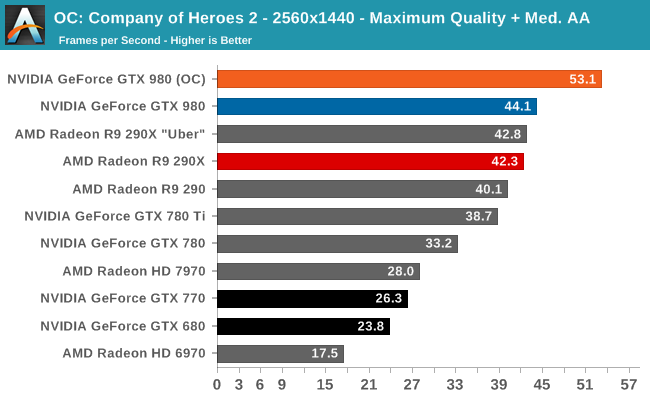
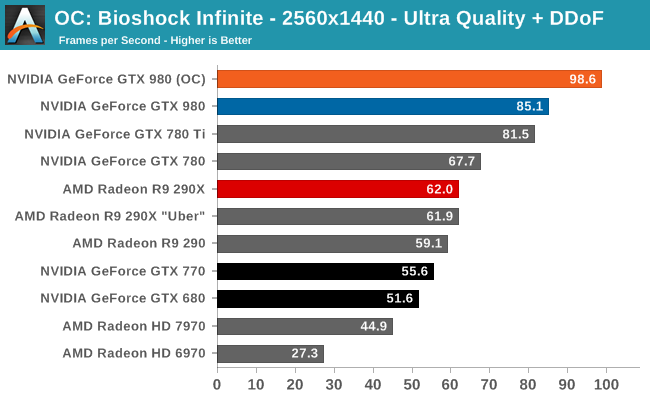
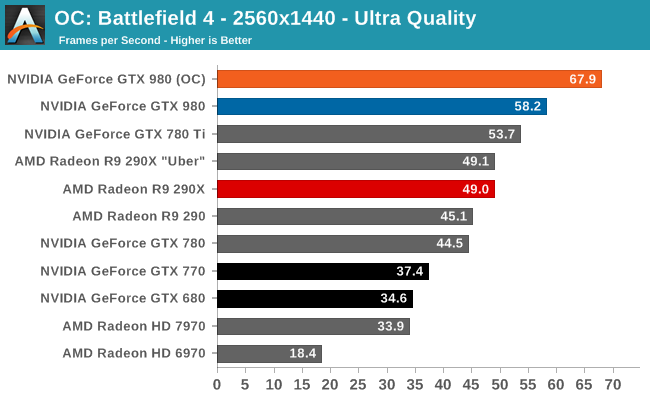
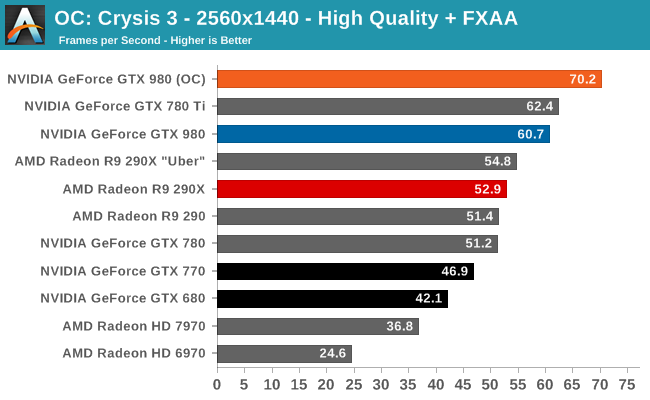
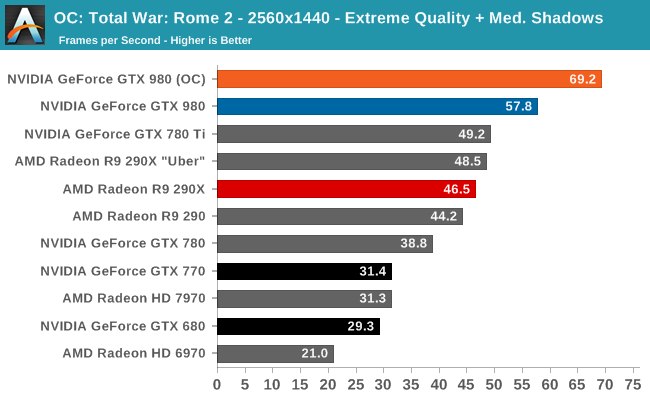
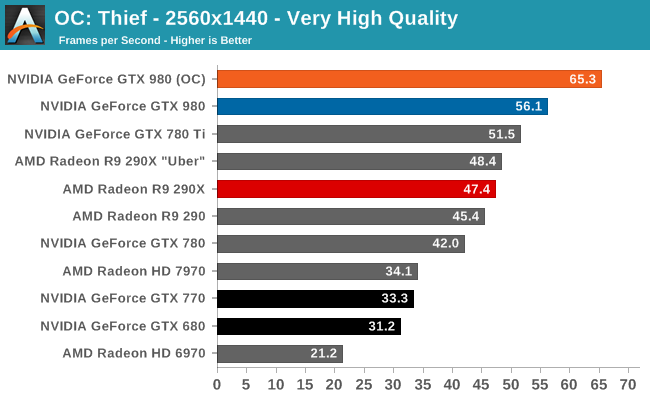
To put it simply, the GTX 980 was already topping the charts. Now with overclocking it’s another 15-20% faster yet. With this overclock factored in the GTX 980 is routinely 2x faster than the GTX 680, if not slightly more.
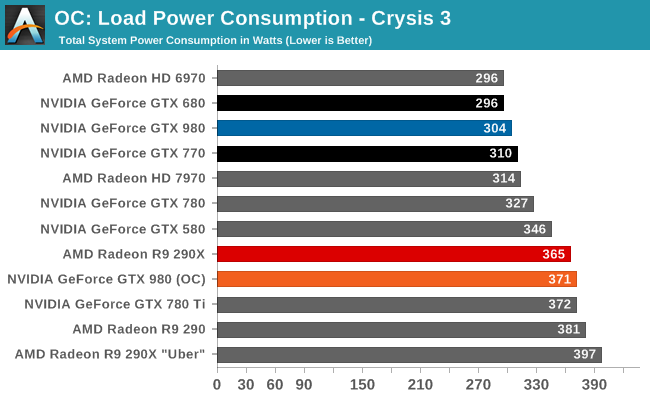
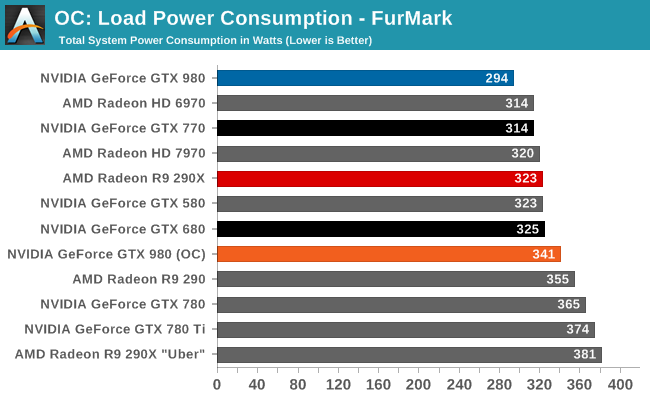
But you do pay for the overclock when it comes to power consumption. NVIDIA allows you to increase the TDP by 25%, and to hit these performance numbers you are going to need every bit of that. So what was once a 165W card is now a 205W card.


Even though overclocking involves raising the temperature limit to 91C, NVIDIA's fan curve naturally tops out at 84C. So even in the case of overclocking the GTX 980 isn't going to reach temperatures higher than the mid-80s.
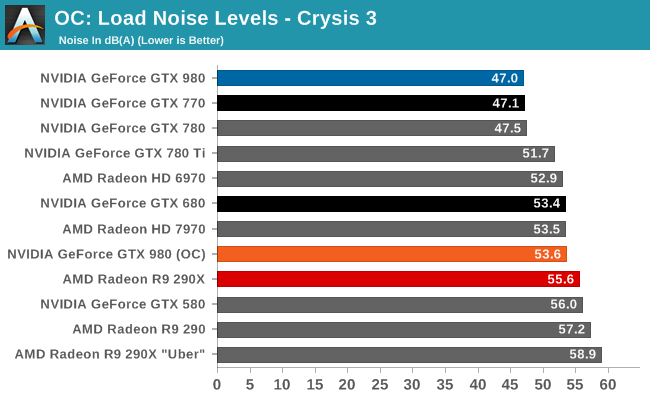

The noise penalty for overclocking is also pretty stiff. Since we're otherwise TDP limited, all of our workloads top out at 53.6dB, some 6.6dB higher than stock. In the big picture this means the overclocked GTX 980 is still in the middl of the pack, but it is noticably louder than before and louder than a few of NVIDIA's other cards. However interestingly enough it's no worse than the original stock GTX 680 at Crysis 3, and still better than said GTX 680 under FurMark. It's also still quieter than the stock Radeon R9 290X, not to mention the louder yet uber mode.










274 Comments
View All Comments
takeship - Friday, September 19, 2014 - link
The situation we have here now is very reminiscent of AMD's CPU position shortly after Core 2 hit the market. Nvidia now has a product with better performance, better efficiency, better (still) drivers & features, and similar pricing and that puts AMD in a bad way. The 3xx series had better seriously wow, or AMD's GPU division is quickly going to see the same market erosion that happened after Core 2/iCore. Personally, i think this is a knockout blow. - soon to be former 7970 ownerchizow - Thursday, September 18, 2014 - link
Maxwell is truly amazing stuff. Great advances from Nvidia in virtually every aspect.Not super thrilled about the 980 price at $550, the 970 price however is amazing at $329. I was going to go with the 980 but 2x970s seem more appealing. 970 is 13/16 SMXes but it retains the full 4GB, full 256-bit bus, full 64 ROPs. Hopefully there's a lot of 970s on the full 980 PCBs.
Jensen just confirmed the prices on the Live Stream.
shing3232 - Thursday, September 18, 2014 - link
they have efficiency advantage because because they use the best 28nm call hpm. they use high performance mobile process of course they are very efficientnkm90 - Friday, September 19, 2014 - link
From TSMCs website ( http://www.tsmc.com/english/dedicatedFoundry/techn... )"The 28nm High Performance Mobile Computing (HPM) provides high performance for mobile applications to address the need for applications requiring high speed. Such technology can provide the highest speed among 28nm technologies. With such higher performance coverage, 28HPM is ideal for many applications from networking, and high-end smartphone/ mobile consumer products."It looks like the hpm process was designed for chips that would dissipate much less than the 150-200W this one does. I seriously doubt someone would use hpm for such high power chips. Also some body had the voltages for the gm204 chip; and the idle voltage was closer to the 0.85V of hp than the 0.9V of HPM
chizow - Friday, September 19, 2014 - link
There's no indication they are using 28nm HPM, even the first Maxwell part (GM107) used 28nm HP and alluded to this amazing power/perf ratio we see today with GM104.It is obvious Nvidia's convergence of mobile *design* (not process) fundamentals helped them as we saw with Kepler, and this will only be further beneficial with their mobile Maxwell designs.
Sttm - Thursday, September 18, 2014 - link
Yeah I was looking at 970 results on other sites... its the 8800gt reborn! Almost top end performance, $220 in savings.chizow - Friday, September 19, 2014 - link
Yep the 970 is amazing price:perf, Newegg has them at the $330 price up to $350 for some custom/OC versions.I did end up going with a single 980 though. The difference in build quality is just too much and SLI with my new G-Sync monitor (Swift) have had issues with my current 670 SLI build. The scaling with SLI is also not exceptional with these Maxwell cards (~60%), so the improvement of 2x970 is actually not that much over a single highly overclocked 980.
Still amazing job by Nvidia, the 980 would have been a grand slam at $500 but it is still an Earl Weaver 3-run blast at $550.
uzun - Thursday, September 18, 2014 - link
When will these cards be available via newegg etc?arbit3r - Friday, September 19, 2014 - link
i would guess later tonight maybe tomorrow though that might be wrong.chizow - Friday, September 19, 2014 - link
They are available on Newegg.com now. Some SKUs are selling out now. I picked up two of the EVGA 980 SuperClocked models.